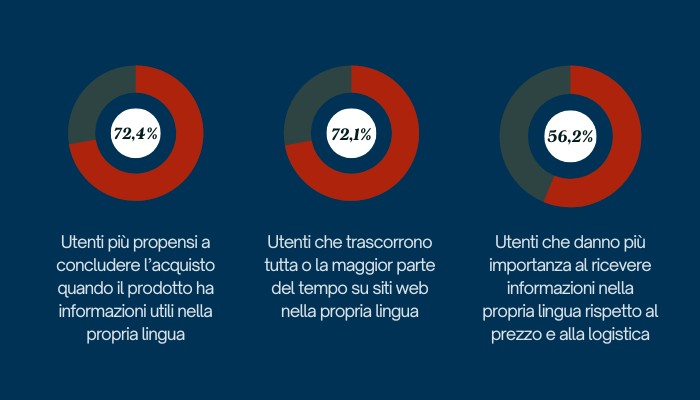Communicating in the target customer’s language.
In how many and what languages to translate the website? And why English alone is not enough
Creating a multilingual website is now a well-established habit for those who plan to broaden their territorial horizons. But what are the languages to be used?
Today more than ever, businesses, large or small, need to translate messages into the specific language of the markets they intend to penetrate. It is not just a translation job, but a strategy to establish a bond between the company and the customer. Speaking the same language as the person you are addressing creates complicity, and as a result promotes the buying process, understanding of the offer, and increases trust and empathy towards the brand.
Therefore, thinking that English is enough to expand into foreign markets is a mistake not to be made. In Europe, a BASE knowledge of English is possessed, unfortunately, by only 38 percent of the population.
The advantages of a translated website for the market you want to enter are, specifically:
- TRUST: Using the client’s native language leads him or her to gain trust more quickly. He will not have the fear of losing useful information, will understand the message better, and will be more likely to believe what he reads. If the information is fragmentary or even incomprehensible, his trust will be broken.
- INFORMATION: People seek information in their native language to inquire about the product and its technical and distinctive features. Features, warranties and delivery terms are desired. Read testimonials from other buyers.
- AVOID EQUIVOCES: Translation makes sure that the message is understood without gaffes and misunderstandings.
- SHARING: Web users are more likely to share articles and information in their native language. In this way, the site can easily reach a wider audience.
- SEO: If content is translated into the languages of interest, it will bring better search engine rankings, thus visibility, higher traffic volume and consequently, more sales volume.

To better understand how language influences buying behavior, research conducted by Common Sense Advisory finds that:
72.4 percent of users are more likely to conclude the purchase when the desired product presents useful information in their own language.
72.1% of users spend all or most of their time on websites they have a full understanding of.
56.2% of users say that receiving information in their own idiom is more important than the business conditions of the desired product, thus price and logistics.
Translation and localization
To meet the needs of today’s user-centric market, the strategy that can be adopted is website localization: while translation simply turns the text into a different language from the original, localization creates a true linguistic and cultural adaptation. In concrete terms, numbering systems, idioms, sarcasm, weight or measurement systems, the sizes, colors with their cultural feedback, etc., are all taken into account. In this way, the message is received as native in one’s native language and integrated into one’s culture.
An example of localization is the Orciani.com ecommerce, implemented by Neikos.
Orciani, a successful fashion company, has an ecommerce usable in Italian and English, for different websites (Italy, Switzerland, UK, US and the rest of the world). The CMS recognizes the user’s location and redirects the user to the home area website, with products, prices, and trading conditions, which vary according to the country of destination of the products.
Another exemplary case implemented by our team is the ecommerce of Bernardini Tartufi. To adapt it to the needs of the company, which interfaces daily with customers from different parts of Europe, it was divided into 4 stores (B2C – B2B catering – B2B retail – B2B distribution) which in turn are divided into 3 different store views: Italian, English and Spanish. Each store has its own sales conditions and price list.
T-Index of Imminent
Relevant help in choosing the languages in which to translate one’s site can be offered by https://imminent.translated.com/, a research center that focuses on disseminating knowledge in the field of intercultural communication and language services.
In this case, its T-Index section is particularly favorable: it ranks countries according to their potential for online sales of a given product or service and estimates each country’s market share in relation to global e-commerce.
The website that communicates in the language of the market makes a difference
Communicating in the language of the country you want to reach is therefore the key to making a difference and approaching individual markets better. It is necessary to strategically assess business and marketing activities and objectives in language in order to then ensure fluency of use for the user, and consequently build complicity and trust.
Are you considering localizing your site, or making a new one that looks at foreign markets? Contact us and tell us about your project.
Share on: